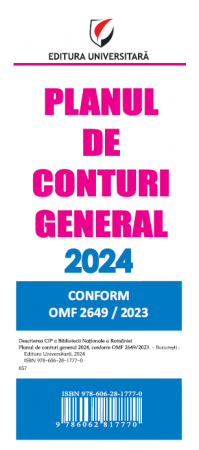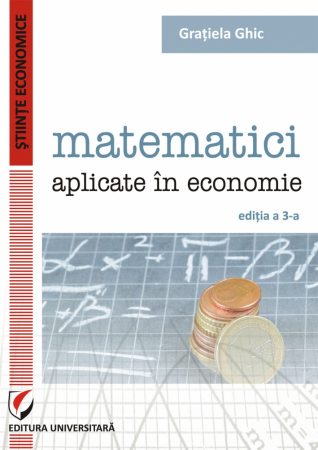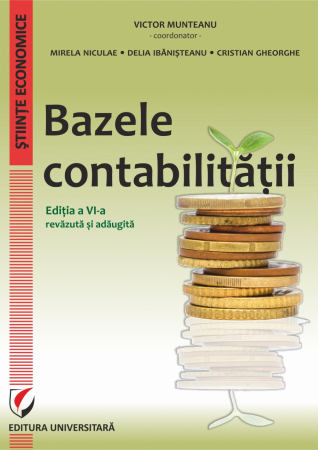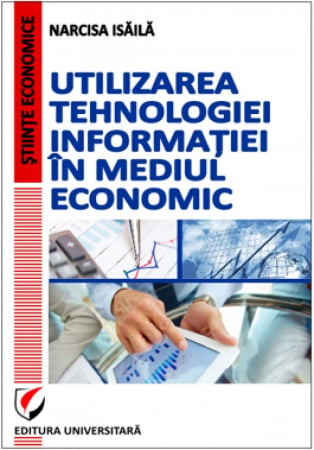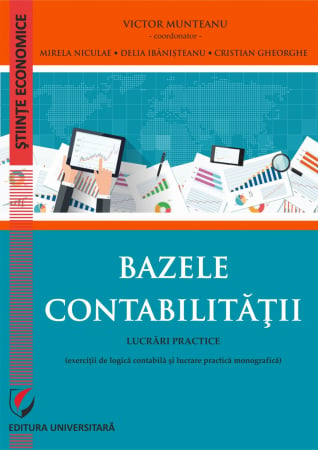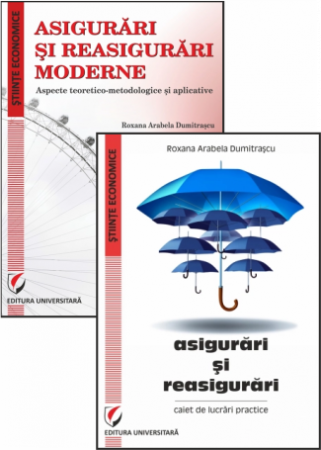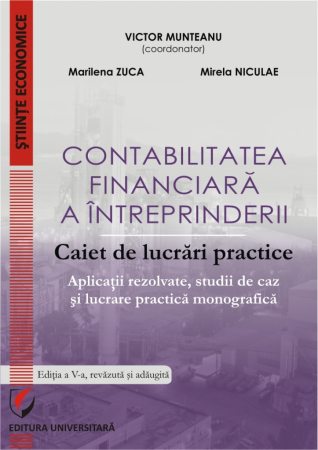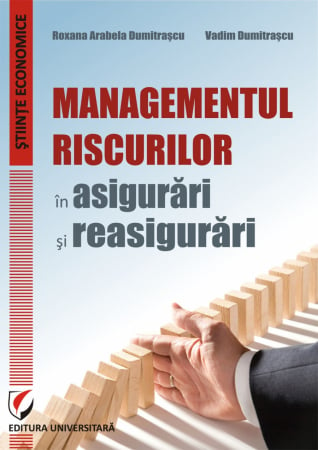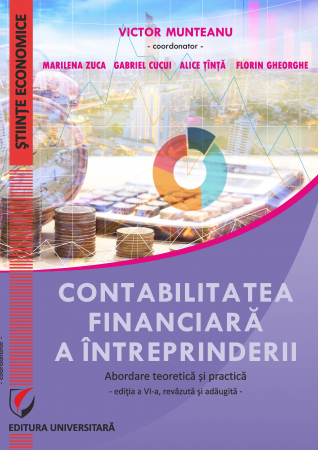Manuscript proposals: [email protected] / 0745 204 115 //// Tracking orders Individuals / Sales: 0745 200 357 / Orders Legal entities: 0721 722 783
6359.png) The conduct of central banks in the European Union and the challenges of the global financial crisis
The conduct of central banks in the European Union and the challenges of the global financial crisis
6359.png)
Publisher: Editura Universitară
Author: Adina Criste, Iulia Lupu
ISBN: 978-606-28-0189-2
DOI: 10.5682/9786062801892
Publisher year: 2015
Pages: 120
Product Code:
9786062801892
Do you need help?
0745 200 357
- Description
- Download (1)
- Authors
- Content
- More details
- Reviews (0)
The present paper is oriented towards the identification and understanding of the paths followed by the central banks, focusing the analysis on the monetary authorities from certain European countries, chosen according to the criterion of relevance. The authors build a sample on the basis of which they manage to identify certain specific and common features regarding the adaptation to the suite of problems encountered in the difficult period after 2008.
By systematizing the approach, by the analyzes performed and by the results obtained, the paper contributes not only to the enrichment of a field in a continuous and rapid change, but also to the signaling of reflection topics that the attentive reader will be able to easily identify and that the authors they will address them in future research and will keep them in the attention of those interested.
By systematizing the approach, by the analyzes performed and by the results obtained, the paper contributes not only to the enrichment of a field in a continuous and rapid change, but also to the signaling of reflection topics that the attentive reader will be able to easily identify and that the authors they will address them in future research and will keep them in the attention of those interested.
-
Conduita băncilor centrale din Uniunea Europeană si provocările crizei financiare globale
Download
ADINA CRISTE - Coordonator
IULIA LUPU
IULIA LUPU
FOREWORD / 7
INTRODUCTION / 10
1. THEORETICAL REFERENCES AND EXPERIENCES ON THE ROLE OF CENTRAL BANKS IN THE GEAR OF THE FINANCIAL SYSTEM / 13
1.1. General aspects / 13
1.2. Guidelines on the governance of a central bank / 15
1.3. Changes in the role of central banks / 21
1.3.1. Duties of the governance of central banks / 21
1.3.2. The foreign exchange regime in the vision of the central banks / 24
1.3.3. Conduct on monetary policy / 27
1.4. The role of central banks on the brink of the global financial crisis / 30
2. COORDINATES OF THE OPERATION OF THE CENTRAL BANKS OF THE EUROPEAN UNION / 39
2.1. Fundamentals of the functioning of the European System of Central Banks / 40
2.2.Characteristics regarding the convergence of the national central banks in the European Union / 45
2.2.1. Remarks on the attributes of central bank governance / 48
2.2.2. Remarks on the political governance of Central banks / 52
3. CHALLENGES TO THE FINANCIAL CRISIS ON THE CONDUCT OF EUROPEAN CENTRAL BANKS / 60
3.1. The global financial crisis in the perimeter of a systemic central bank. Common challenges and peculiarities regarding the role of the European Central Bank / 60
3.2. Challenges of central banks in the European Union / 67
4. ANALYSIS OF THE MODULE OF ADAPTATION OF CENTRAL BANKS TO THE CHALLENGES OF THE GLOBAL FINANCIAL CRISIS / 89
4.1. Comparative analysis on monetary policy / 89
4.2. Financial stability policy / 95
FINAL REMARKS / 100
ANNEX 1/102
INFLATION EVOLUTION IN EUROPEAN COUNTRIES WITH INFLATION AIMING STRATEGY / 102
ANNEX 2/106
REACTIONS OF SOME CENTRAL BANKS TO THE CHALLENGES OF THE GLOBAL FINANCIAL CRISIS / 106
SELECTIVE BIBLIOGRAPHY / 111
ABBREVIATIONS / 118
LIST OF TABLES / 119
CASE LIST / 119
GRAPHIC LIST / 119
INTRODUCTION / 10
1. THEORETICAL REFERENCES AND EXPERIENCES ON THE ROLE OF CENTRAL BANKS IN THE GEAR OF THE FINANCIAL SYSTEM / 13
1.1. General aspects / 13
1.2. Guidelines on the governance of a central bank / 15
1.3. Changes in the role of central banks / 21
1.3.1. Duties of the governance of central banks / 21
1.3.2. The foreign exchange regime in the vision of the central banks / 24
1.3.3. Conduct on monetary policy / 27
1.4. The role of central banks on the brink of the global financial crisis / 30
2. COORDINATES OF THE OPERATION OF THE CENTRAL BANKS OF THE EUROPEAN UNION / 39
2.1. Fundamentals of the functioning of the European System of Central Banks / 40
2.2.Characteristics regarding the convergence of the national central banks in the European Union / 45
2.2.1. Remarks on the attributes of central bank governance / 48
2.2.2. Remarks on the political governance of Central banks / 52
3. CHALLENGES TO THE FINANCIAL CRISIS ON THE CONDUCT OF EUROPEAN CENTRAL BANKS / 60
3.1. The global financial crisis in the perimeter of a systemic central bank. Common challenges and peculiarities regarding the role of the European Central Bank / 60
3.2. Challenges of central banks in the European Union / 67
4. ANALYSIS OF THE MODULE OF ADAPTATION OF CENTRAL BANKS TO THE CHALLENGES OF THE GLOBAL FINANCIAL CRISIS / 89
4.1. Comparative analysis on monetary policy / 89
4.2. Financial stability policy / 95
FINAL REMARKS / 100
ANNEX 1/102
INFLATION EVOLUTION IN EUROPEAN COUNTRIES WITH INFLATION AIMING STRATEGY / 102
ANNEX 2/106
REACTIONS OF SOME CENTRAL BANKS TO THE CHALLENGES OF THE GLOBAL FINANCIAL CRISIS / 106
SELECTIVE BIBLIOGRAPHY / 111
ABBREVIATIONS / 118
LIST OF TABLES / 119
CASE LIST / 119
GRAPHIC LIST / 119
The global financial crisis has brought to the fore questions and disputes that had been somewhat blurred during the period of rise and consolidation of the free movement of capital. Confidence in the functioning and self-regulation capacity of markets, often, the expression having a connotation strictly limited to financial markets, was equal to the enthusiasm of investors stimulated by the inventiveness of the creators of complex and very profitable products. Moreover, the mainstream claims new freedoms and the limitation of any kind of intervention likely to disrupt the innovation cycle and the unhindered expression of market forces.
The onset of the crisis found the European Union in the process of building a banking union and consolidating the monetary area of the single currency, difficult and germ-carrying processes of instability and erosion of the control levers.
The hardest attempt by theorists and practitioners has been to ascertain and justify the need to mobilize resources outside the market to stabilize the financial system threatened with collapse under the weight of the colossi that had ensured its apparent brilliance until then.
The causes and accumulations that created and brought to the forefront the crisis situation were also revealed. But the time was too short for canonically guaranteed actions and interventions, so that the institutions of macroeconomic policies exceeded the alignment and applied solutions from the classical arsenal, but also from the area called unconventional. It seems that regulators always remain under critical observation, because they do not see in depth and perspective the development of phenomena and do not take preventive measures, but also because there is and distorts the framework in which the freedom of movement of capital must manifest.
And yet, this experience has reaffirmed the importance of a macroeconomic, institutional and regulatory framework for ensuring financial stability. The institutions responsible for macroeconomic policy have assumed the role of command center and have revised and diversified their working tools. The problem is whether, in addition to harming the river, the measures taken and the instruments used will ensure the conditions of long-term stability, in order to avoid wasting resources and altering the social environment. These challenges have generated widespread debate in academia and politics, which has coagulated around the idea of redefining the responsibilities of authorities involved in guiding macroeconomic policies and finding solutions to restore the smooth functioning of the financial system.
Such concerns were also included on the agenda of the Financial and Monetary Research Center "Victor Slavescu", one of the research projects in 2014, resulting in ideas and observations capitalized through this paper.
The present paper is oriented towards the identification and understanding of the paths followed by the central banks, focusing the analysis on the monetary authorities from certain European countries, chosen according to the criterion of relevance. The authors build a sample on the basis of which they manage to identify certain specific and common features regarding the adaptation to the suite of problems encountered in the difficult period after 2008.
By systematizing the approach, by the analyzes performed and by the results obtained, the paper contributes not only to the enrichment of a field in a continuous and rapid change, but also to the signaling of reflection topics that the attentive reader will be able to easily identify and that the authors they will address them in future research and will keep them in the attention of those interested.
Dr. Constantin Marin
Director,
"Victor Slavescu" Financial and Monetary Research Center
The onset of the crisis found the European Union in the process of building a banking union and consolidating the monetary area of the single currency, difficult and germ-carrying processes of instability and erosion of the control levers.
The hardest attempt by theorists and practitioners has been to ascertain and justify the need to mobilize resources outside the market to stabilize the financial system threatened with collapse under the weight of the colossi that had ensured its apparent brilliance until then.
The causes and accumulations that created and brought to the forefront the crisis situation were also revealed. But the time was too short for canonically guaranteed actions and interventions, so that the institutions of macroeconomic policies exceeded the alignment and applied solutions from the classical arsenal, but also from the area called unconventional. It seems that regulators always remain under critical observation, because they do not see in depth and perspective the development of phenomena and do not take preventive measures, but also because there is and distorts the framework in which the freedom of movement of capital must manifest.
And yet, this experience has reaffirmed the importance of a macroeconomic, institutional and regulatory framework for ensuring financial stability. The institutions responsible for macroeconomic policy have assumed the role of command center and have revised and diversified their working tools. The problem is whether, in addition to harming the river, the measures taken and the instruments used will ensure the conditions of long-term stability, in order to avoid wasting resources and altering the social environment. These challenges have generated widespread debate in academia and politics, which has coagulated around the idea of redefining the responsibilities of authorities involved in guiding macroeconomic policies and finding solutions to restore the smooth functioning of the financial system.
Such concerns were also included on the agenda of the Financial and Monetary Research Center "Victor Slavescu", one of the research projects in 2014, resulting in ideas and observations capitalized through this paper.
The present paper is oriented towards the identification and understanding of the paths followed by the central banks, focusing the analysis on the monetary authorities from certain European countries, chosen according to the criterion of relevance. The authors build a sample on the basis of which they manage to identify certain specific and common features regarding the adaptation to the suite of problems encountered in the difficult period after 2008.
By systematizing the approach, by the analyzes performed and by the results obtained, the paper contributes not only to the enrichment of a field in a continuous and rapid change, but also to the signaling of reflection topics that the attentive reader will be able to easily identify and that the authors they will address them in future research and will keep them in the attention of those interested.
Dr. Constantin Marin
Director,
"Victor Slavescu" Financial and Monetary Research Center
If you want to express your opinion about this product you can add a review.
write a review

![The conduct of central banks in the European Union and the challenges of the global financial crisis [1] The conduct of central banks in the European Union and the challenges of the global financial crisis [1]](https://gomagcdn.ro/domains/editurauniversitara.ro/files/product/large/conduita-bncilor-centrale-din-uniunea-european-si-provocrile-crizei-financiare-globale-828-93222.jpg)
